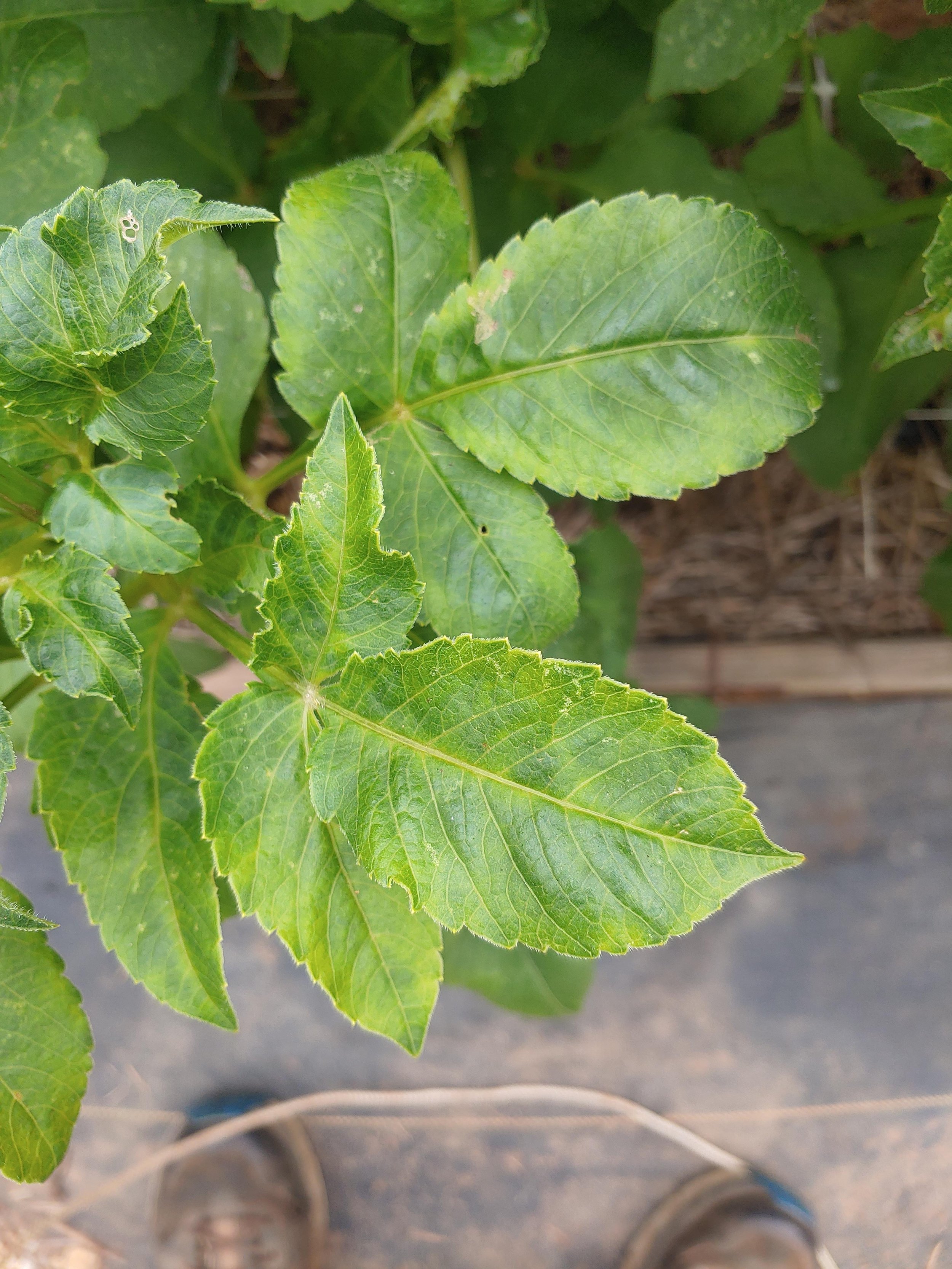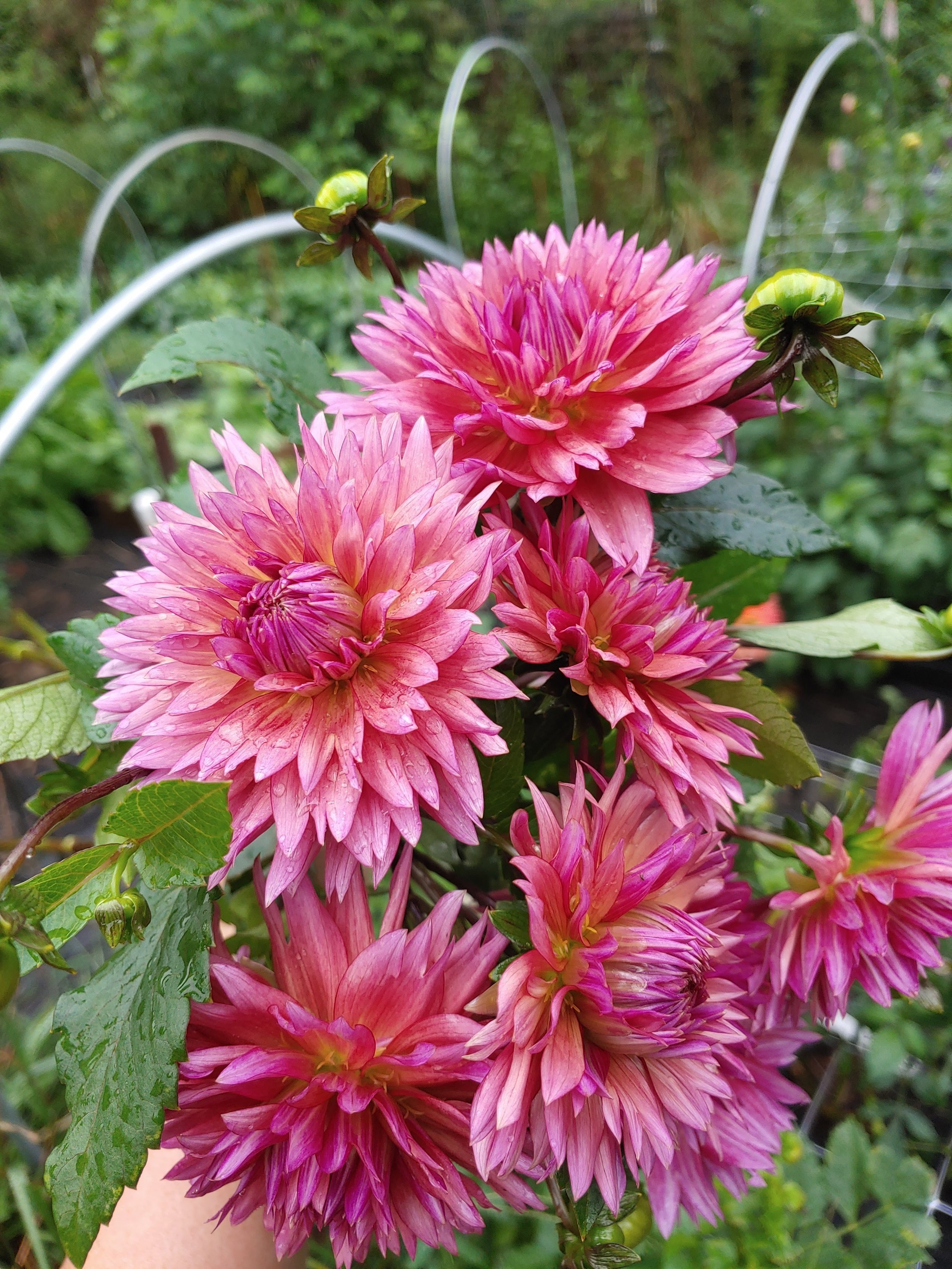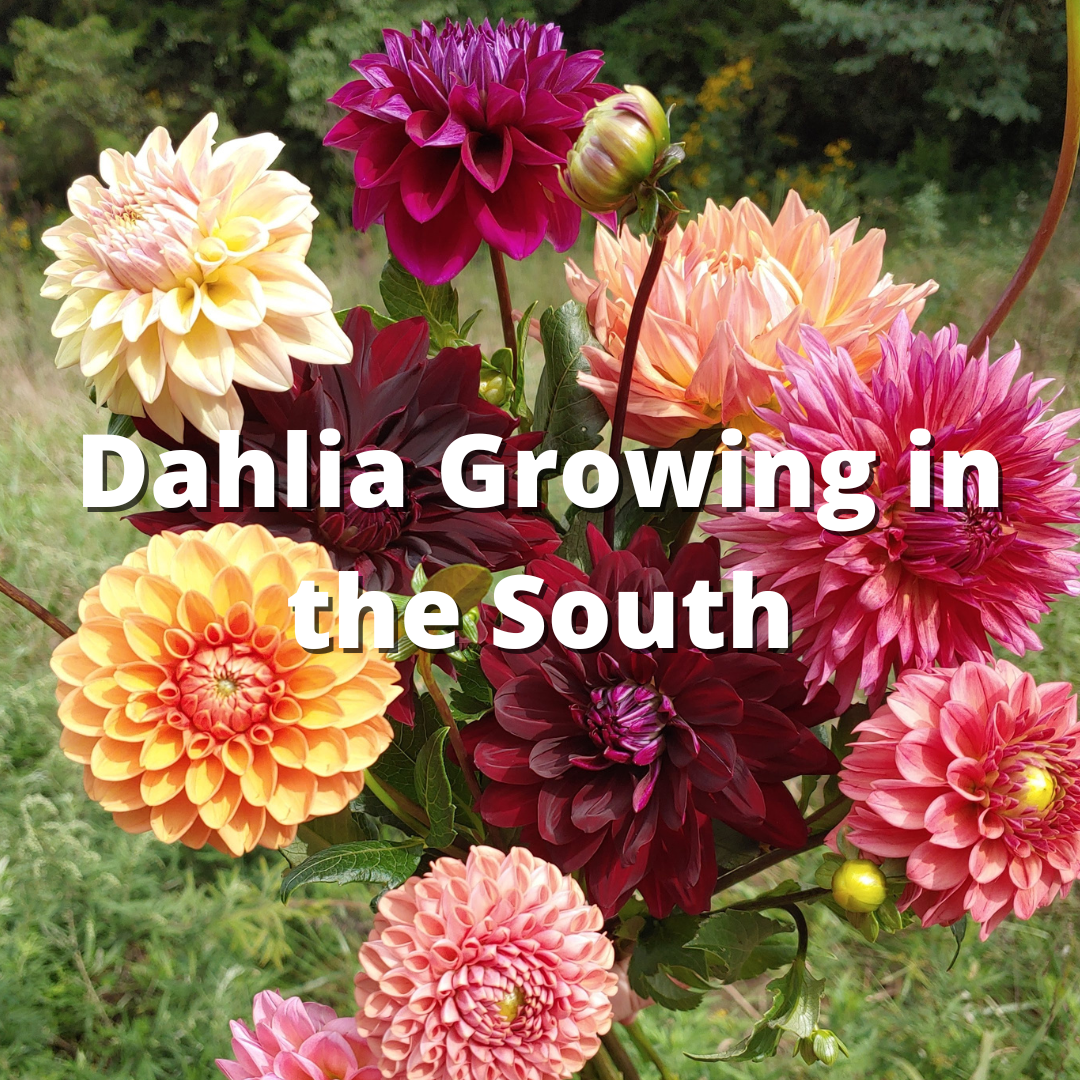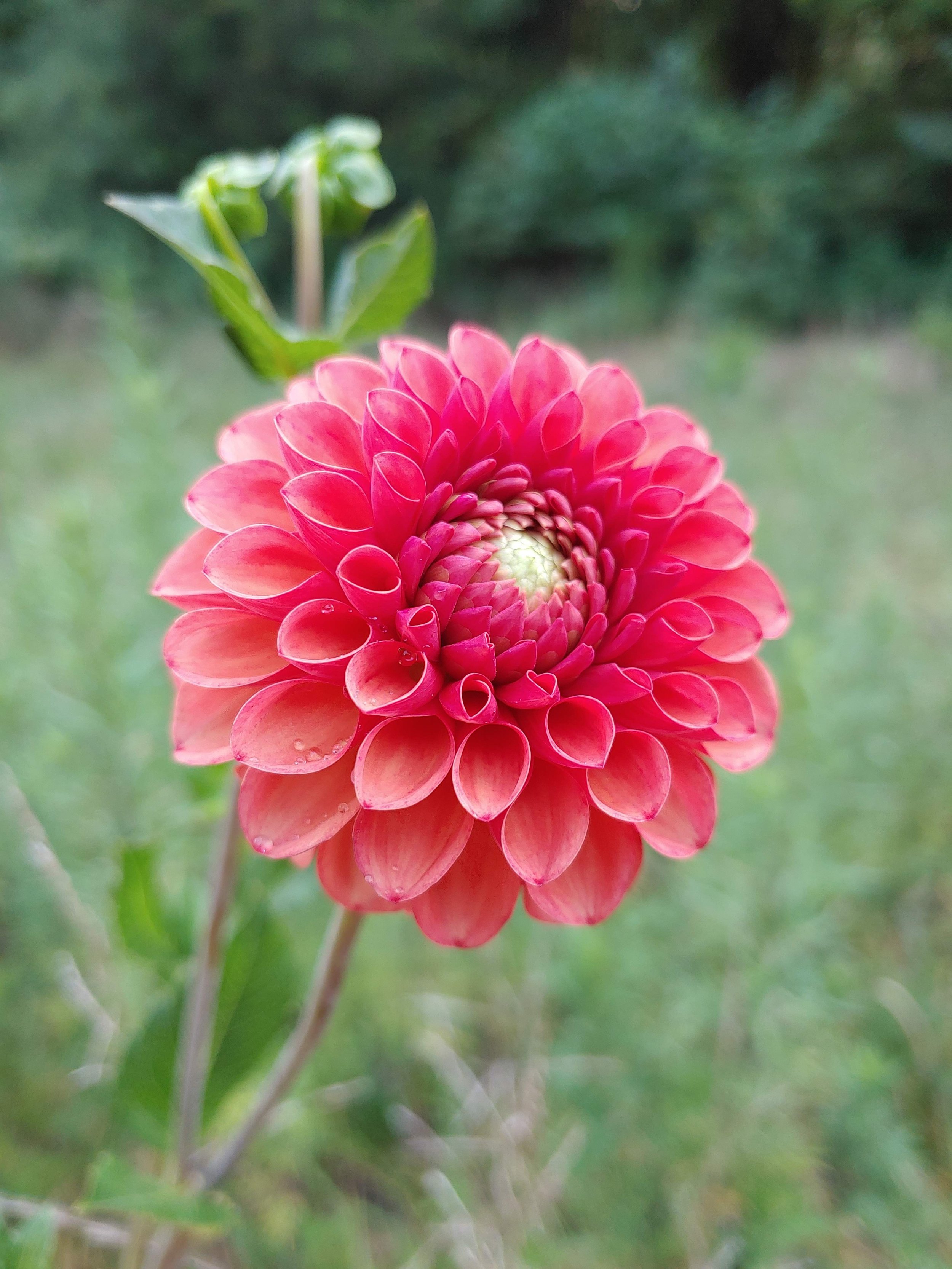
Dahlia Game Plan 2024: Bug Control- Part 1
I’ve been getting so many emails about how to get rid of bugs that I know you all are ready for this post! So let’s get started! This is going to be a two part series because it’s just too much for one post.
There are (unfortunately) lots of bugs that like Dahlias- at least here in my hot Southern climate. If you live elsewhere, you may be fortunate enough to not have to deal with some of these (lucky you). I like to break the common pests list into 2 categories: those that do petal damage and those that do plant damage. Some do both.
Petal Damage:
-Thrips
-Japanese Beetles
-Cucumber Beetles
-Earwigs3
-Grasshoppers
Chewed up Peaches N Cream
Plant Damage:
-Thrips
-Leafhoppers
-Tarnished Plant Bugs
-Spider Mites
***Now you may wonder- Why do we care if a leaf gets damaged or nibbled? Well unfortunately, the plant damage caused by these pests is how viruses spread. So we have to care about it. ***
Luckily, the control methods for plant damaging pests often work for petal damaging pests and vice versa. However before we get to controlling pests, let’s talk about preventing them!
Prevention is key and the key to preventing pests is to scout and observe your crops! So what does that mean?
To be an effective scouter, you need to walk your field/garden on at least a weekly basis to specifically look for pests (diseases too). We have a big field so we walk with a clip board and the camera open on our phones. Pictures are a great documentation record. You can easily track changes from week to week. After the weekly scout, notes are compared. This information will then factor into what pest control or prevention methods we will use later on in the week.
Also after several years, you’ll be able to know when certain pests are going to appear in your area. This is when prevention really plays the biggest role in your bug battle.
Common Forms of Pest Prevention:
1. Timing - Adjusting the timing of your planting can mean you avoid certain pests attacks. For example, Japanese Beetles attack the worst during late May- early July in my area. They do the most damage to petals. So by moving our planting time to May, it means we don’t have lots of blooms until August. Thus avoiding the petal damage done by Japanese Beetles.
Now, I know a lot of home gardeners leave their tubers in the ground and this means blooms in June. So what are you to do? Well, the easiest idea would be to prune your plants back in early June and delay bug development. But if you must have blooms, I’d suggest the organza bag method. It’s the most full proof for preventing petal damage.
2. Water - Water is a powerful and easy prevention method. A few years ago we started using an overhead sprinkler to cool our dahlias in the middle of the day during the hot summer months. It worked well- 5-10 minutes twice a day during the hot part of the day. However, I also noticed that I didn’t have any powdery mildew on my crop until mid fall (when we stopped using the water to cool) and also the spider mite population was very low. So I started researching to see if it was just coincidence or if there was something real there. Turns out that powdery mildew comes on during period of heat and dryness but with high humidity. So by wetting the plants down each day, we were keeping the dryness at bay and cooling them. Also the water rinses off any PM spores that might be hanging out on the leaves. Spider mites also tend to attack when plants are stressed from heat and drought. So controlling those conditions led to a lower population of spider mites in the field.
Another way to use water is to simply have water in/near your field/garden. Bird baths, fish ponds, frog ponds, etc. Water brings in beneficial insects and animals very quickly. They all need it to survive. So if you provide it, they will come. Back in 2018, we added a duck pond and frog pond to our farm as means of controlling drainage/water run off. I saw a huge increase in the number of birds on our farm over the next year. Bullfrogs like crazy too!
3. Spray - There are a lot of pest control sprays out there than can be used when pest populations are low to prevent larger outbreaks. This leads into part 2 of this short series so we’ll talk about it more next time.
Dahlia Game Plan 2024: Getting Organized- Fertilization
The new year has begun and it’s time to get ready because dahlia season will be here before we know it! For some of us it’s only a month away and others will have to wait until late Spring.
This series is designed to help you develop a more organized approach to growing your dahlias. Today I want to introduce you to my spreadsheet that I use for tracking fertilization and pest control.
So why do I track these 2 things specifically?
- Because there’s more than just me working around here. This way my employees know the bigger picture of what is happening in the dahlia field.
- Because in a few years, I’ll have valuable data that I can use to project things like: How much fertilizer do I need to buy at the beginning of the season? When do the Japanese Beetles usually show up?
- Because it keeps me accountable to make sure my dahlias are getting cared for regularly
Today we are going to concentrate on the fertilization side. Pest Control is coming in the next blog.
First off consistency is very important. We like to eat regularly, so do our plants. Dahlias aren’t a plant it and forget it type of thing. Consistency can look different depending on your goals and amount of time. We are a commercial farm so we fertilize every week. But maybe every other week works for you or even once a month.
Just keep in mind you will see different results depending on how often you fertilize. I recommend at least every other week for the home gardener.
Sylvia, Pink Sylvia, Caitlyn’s Joy and Sweet Nathalie
Now- what are we fertilizing with? Dahlias need different nutrients at different stages. From sprout to around the 2 month mark, they need a complete fertilizer (Complete fertilizer has nitrogen, potassium and phosphorus) which has a higher percentage of nitrogen.
I really like to use liquid organic fertilizers in this instance. My favorite is to mix fish emulsion with the Rose and Flowering fertilizer from Neptune’s harvest. This gets the nitrogen to the highest percentage in your mix but also gives the plants some phosphorus (P) and potassium (K). I like to go ahead and give the P and K in the early stages because I feel it really helps out the early bloomers. They are going to be setting buds around the 40 day mark.
Once you see bud development, it’s time to swap your strategy around. Now the plants need a higher percentage of phosphorus and potassium. But you can’t neglect the nitrogen. You just don’t need as much. I especially think the nitrogen is important if you have a long flowering season. They are going to need a lot of food to keep going.
I like to use a few different things. Alaska Morbloom is great- 0-10-10. I would add a low dose of some nitrogen (fish emulsion, kelp, etc.) if this is the only fertilizer I was using. I also like the Southern Ag Bloom Booster- 10-30-20. (There are a lot of companies that make a similar product to this as well).
I do recommend taking a trip to your local nursery or feed and seed. See what they have in stock. Fertilizer can be heavy and expensive to ship. And it’s always good to support your local businesses. Remember there are a lot of similar products out there- it’s more important you know what nutrients to focus on during the different stages of growth.
Peaches N Cream
So how do we apply it? Well if you are really lucky, you have a fertigation system that feeds it through your irrigation system. Unfortunately I don’t. We use a battery powered backpack sprayer. I highly recommend the My4Sons brand. I’ve had mine for years.
You can also mix ingredients in your spraying. You don’t have to spray each one individually. But you do need to research online or read the bottle to make sure it mixes well with others. If you have an oil based product in your mix, I recommend using an emulsifier product to keep everything mixed up.
If you are working on a small scale, a watering can or pitcher works just as well. They also make hand crank sprayers. Dahlias benefit from a foliar spray because they have such broad leaves.
Coseytown Clem
Lastly do make sure you are watering consistently. Hydration is just as important as feed for the plant! Irrigation systems are pretty easy to set up. And winter is a great time to research how to do it!
So Game Plan Step 1- Get Organized and decide what your fertilization schedule will be this year.
Back to the Basics with Dahlias
If you are new to dahlias this post should give you some help to get started. If you’ve been growing a few years, this will be a good refresher course. So Back to the Basics we go!
1. Before you buy a tuber, survey your yard, add any compost- let’s get our mindset in place. Growing plants is a life long journey. Perfection won’t be gained in year 1 or 10 even. It’s a journey we embark upon to learn more about the natural world, to bring beauty into our lives, to teach us many lessons (least of all patience), and to share the beauty/bounty we grow with others. There is no succeed or fail, only lessons learned, knowledge gained, and relationships formed (with people and nature).
2. Remember what plants need- Every plant needs light, water, and something to grow in (usually soil). Dahlias specifically need full sun (6+ hours a day), rich soil with good drainage, and moderate water during the green growth stage and more water when blooming.
3. Dahlias need support. Most dahlias are tall plants- tall enough to need support. So place a stake or wire cage when you plant or install support netting after a full row.
4. Dahlias are hungry plants. So don’t skimp on the compost or fertilizer— Make sure your soil has enough nutrients to feed your plants properly. They prefer soils higher in phosphorus and potassium, lower in nitrogen. Too much nitrogen will create lush green plants with little to no blooms. Get a soil test from your local extension so you have a baseline to begin.
5. The more you cut, the more they bloom. I often hear of new growers being afraid to cut their blooms but the more you cut, the more the plant is triggered into producing more blooms! If you pinch out the central growing tip when the plant is around 18”-2’ tall, it will cause the plant to branch and give you more stems.
6. Dahlias are the ultimate generous gardener plant. Place one tuber in the ground in the Spring and dig up a whole clump in the fall. Or if you live in a warm climate, overwinter them in the ground and divide your generous clump in the spring and turn all your friends into Dahlia Lovers too!
So if you read through this and thought- but I still didn’t have the results I wanted with my dahlias.
***Read through again. Really look into each step and evaluate your growing. The majority of issues with growing dahlias can be traced back to the simplest things. ***
For example, for years, I always told myself- I’ll get the netting up before they get too tall! HA!!! And for years I had so many floppy plants- lost loads of stems that I could have sold! So now I put my netting up as soon as a row gets planted. The planting is not finished unless the support netting has been installed.
For the first several years, I didn’t soil test and I had lackluster blooms. They would be small or misshapen. I finally tested my soil and found I was very low in the crucial nutrients that create bountiful blooms.
It took me several years to really believe that I could cut 2’ stems on my dahlias without damaging the plants. But then I grew a variety that was 8’ tall. I had to cut long stems in order to keep it manageable. That taught me that if I cut the first stems long, then I would continue to have long usable stems throughout the season (instead of short weak ones).
All that to say— Don’t Ignore the Basics!!! When I see new growers who have bountiful blooms on healthy plants, I can always trace it back to following the basics.
So go grab a few tubers to try this year and then over the next few months, begin to plan how you will implement the basics in your garden. Follow along with me here, lots more info coming. Also lots of info already available. See that tag under the title that says “Dahlias”. Click that and it will take you to all the posts about dahlias on this blog.
Want to go deeper? Try out our Dahlia Growing in the South Virtual Workshop!
Rusty Dahlias
“And something in a rust tone….” This is a request I’ve heard so many times over the past 2 years from my florist customers! Rust has become one of the popular accent colors for fall palettes.
I thought I’d share some dahlia varieties that I use to fulfill this color request. Rust, like peach, is kinda up to interpretation. Do you want rusty red, rusty brown, rusty tan? So I consider it a color family and not really a single color. Thankfully dahlias have a lot of tonality to them so it makes it easy to get the range a florist needs.
All That Jazz
All That Jazz- This one fits under the ‘Rusty Red’ category. Prolific bloomer, began blooming mid September from a mid May planting. Tallish at around 4’+. The color fades into golden tan tips which complement the rust color nicely. Photographs a bit red but really is a rusty color. Great tuber maker too- makes nice fat tubers with an easy to divide habit. Definitely growing more of this one next year!
Cornel Bronze
Cornel Bronze— ‘Rusty Bronze’ You know I had to include this one. It’s in the ‘Rusty Bronze’ category. It’s an easy dahlia to grow, blooms prolifically and has a neat plant habit so it doesn’t turn into a rangy mess. Good tuber maker (although can be a pain to divide).
Brown Sugar
Brown Sugar- ‘Rusty Red Brown’- Dark stemmed so it adds a bit of drama. I like this dahlia although I’ve heard some others in warm climates who don’t think it’s all that. It has always grown well for me. It is a flusher type of dahlia (meaning it’s going to throw most of it’s blooms in a short period). That can be a downside because the color is definitely unique to the fall season. So you’ll want to time it well. Good tuber maker- nice fat ones that store well.
Copper Boy
Copper Boy- ‘Rusty Copper Red’ - This one is a good alternative if you don’t like Brown Sugar. It’s a bit more copper toned red, blooms early— so make sure to plant accordingly. If you have a market for this color early in the season, you can probably get two flushes out of it. Has a plant habit similar to Linda’s Baby- which means you need to cut deep to force long stems. This is my second year growing it and so far I’m a fan.
Valley Rust Bucket
Valley Rust Bucket- ‘Rusty Orange’ This is a two tone dahlia- I love two tones because they always work well with so many palettes. They have an instant ‘blendability.” I wish the blooms were a bit bigger - this is a 2-3”. But it definitely makes up for it the number of blooms. Pretty good tuber maker as well!
Totally Tangerine
Totally Tangerine- ‘Rusty Copper Tan’ I wouldn’t have considered this to be in the rust palette when I first saw it. Early in the season, it’s a warm peach. But as the weather cools, it goes more copper with some tan as it fades. I offered it to a florist who was looking for some really unique blooms for a styled shoot in the rust palette and she loved it. It doesn’t have a great vase life so I’d relegate it more to the garden but if you do design work and you grow your own blooms, it’ll hold for a day or two.
Sierra Glow
Sierra Glow- ‘Rusty Tan- This is a great dahlia if you need a large bloom in the rusty palette. Sierra Glow has always been a good one for my hot climate. Holds well in the vase- it’s hard to find large dahlias that have great vase life in a hot climate but this one works!
Ice Tea
Ice Tea- ‘Rusty Terracotta Brown’ This was my original rust dahlia- the first variety I had in this color palette. I first clued in to this color trend when I couldn’t keep this color in stock a few years back. It’s a good consistent bloomer. Makes good tubers but you need to be very careful when digging them. It creates a tuber with a round bulbous body but a very skinny neck. It’s very easy to break the necks when digging so lift carefully.
Honorable Mention: These 3 dahlias above blend very well into the rust palette so I’m including them. From left to right- Rose Toscano, KA Mocha Katie, and NTAC Mai Li
There you have it- my favorite rust dahlias that work well in a hot climate! If you aren’t growing rust tones- it’s time! Color trends move and change but most of them stay around for a few years so you’ve got time to grow this beautiful tone!
Things You Can Do Now to Prepare for Next Dahlia Season
It’s almost winter time and hopefully you’ve dug your tubers (if you needed to). It’s time to enjoy the pictures and memories of a beautiful dahlia season!
However, if (like me) you’re just not content with sitting around, there are several things you can do now to prepare for an amazing dahlia season next year.
Sonic Bloom
1. Prepare your soil. First off, take your soil test. Fall is the best time for soil testing on a regular basis. And it’s a really good idea to take the test around the same time each year. This way you can compare your progress from year to year. Fall is also a good time because any amendments you need to add take time to incorporate into your soil. The winter gives you time for this incorporation to happen.
After soil testing and adding any amendments you need, think about the texture and drainage of your soil. The handy thing about dahlias is that they tell you what they need in the soil. If your soil doesn’t drain well enough, you’ll see lenticles on your tubers. If the soil lacked food, the plant will grow small and spindly and usually the tubers will be small and not prolific. The visual appearances of the plant and tubers tell you what you need to know.
We are strategically adding compost and shredded leaves in several places this fall. We’ve identified where our drainage was poor and are working to correct it. Keep in mind that soil improvements can take several seasons. (This is why you want to take soil test each year— they help you to know if you are moving in the right direction.)
Muchacha
2. Research. It’s time for one of my favorite parts of growing dahlias— Deciding what varieties to add to my field for the next year. You can do this many ways— just add what’s pretty or decide you need more of a specific color or form. What suits you. Since we are a commercial cut flower farm, we are always looking for great cut flower varieties and varieties that thrive in heat. Those are the main priorities. After that, I usually assess my current collection to see what colors I need to increase. I try to ascertain what the color trends are going to be 2-3 years out because it can take that long to build up enough stock of a particular color.
I like to use Dahlia Addict (www.dahliaaddict.com) to begin my research as this site shows who has what and when it’s for sale. I also save pictures from Instagram all season long. Now if the time to review them. We all know that it’s easy to get dahlia mania and to want them all. But I’ve found that it’s good to have some goals when adding to your collection- this helps keep the dahlia hobby from breaking the bank! (I know you all know what I mean!)
Second, you can also research any problems you had- specific pests, not enough water available or if you had some climate type issues- how to deal with them. It’s beneficial to think through these things when you are not in the stress of the main growing season. There’s often more mental space to solve a problem.
Esli
3. Organize your game plan. One of the best things I did this past year was to stop mid season and get organized in regards to my feeding and pest management. I created a spreadsheet where we could record what we were fertilizing with each week and also what pesticides we used. This year, I’ll be adding a column to track what pests where in the field and when. We would scout each week but didn’t write down exactly what we saw. Lastly, we recorded what we sprayed for fungus issues too.
I know how hard it is to keep up with this stuff during the season so make your game plan now. Buy what you need before the season begins. Also figure out a strategy to ensure your don’t put off feeding and spraying your plants. They really do produce and give back to you when you take care of them. If you are a farmer- delegate this to an employee. That was also one of the best decisions I made. They have less floating around their minds in regard to the farm and can make the job a priority. This delegation ensured it got done on time every week! And our stem production and tuber harvest was better for it!
You can also set a record keeping system for other data in winter: storing pictures, recording bloom dates, stem counts. All those things you wish you had done at the end of the season. Go make a list and then work through setting up the systems you need through the winter.
It’s too busy in the middle of harvesting to invent a system so do it during the winter when it’s slow!
These are three of the best things you can do to ensure a great dahlia season for 2024!!























